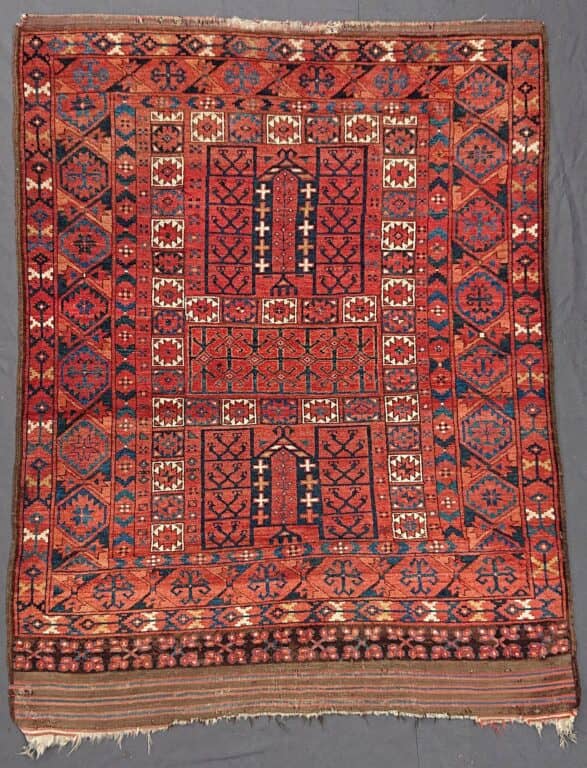Early Ersari Engsi
Description
This early Ersari engsi, or tent door rug, dates to the early nineteenth century and was almost certainly made in the middle Amu Darya region. It is in our exhibition of TRIBAL WEAVINGS as part of the CADA Exhibition Week.
The four central panels with four and five rows of field ornaments in the bottom and top half respectively are separated by a large horizontal bar and two vertical bars with a tree in the centre and a column of crosses flanking the tree. A hook finishes off the pointed tops of these dividing panels, with a comb design (possibly an amulet?) forming their bottom ends.
Surrounding the central panels at the sides and the top is a chain of squares which are filled with one large star each in an alternating sequence of red/white and red/blue. The dominance of the white marks these out as particularly striking structural elements. This motif is also found around the horizontal bar in the centre.
Two borders with smaller geometric designs, notably triangles and squares, flank the star borders along the sides. A sequence of three further borders completes the design on the sides. They, too, are filled with geometric motifs inside hexagonal structures, the main border containing stars which echo those in the borders around the central panels.
The elem, or bottom border, is a classic pattern of trefoils arranged in a cruciform fashion along two crossing diagonals. The striped kelim end at the bottom is still there, albeit with slight damage to the weave.
The colour scheme of this engsi is classic Ersari: a very warm madder red, an orangey secondary red, two shades of blue, a blue/green, yellow and off white, plus the undyed dark brown wool in the elem. The selvedges are overcast in dark brown goat hair.
According to the late Jon Thompson, early Ersari engsi are “surprisingly rare” (Louise W Mackie & Jon Thompson, eds, Turkmen. Tribal Carpets and Traditions. The Textile Museum, Washington, 1980, p. 178). There was one such example, not unlike the piece in hand, in the Sotheby’s Sale of Turkmen and Antique Carpets from the Collection of Dr. and Mrs. Jon Thompson, New York, 16 December 1993. It is published as lot number 32 with an estimate of $10,000 – 12,000. Thompson dates this (“conservatively”) to the early 19th century or earlier.
Two other engsi from the same area are in the Hoffmeister Collection, published in Elena Tsareva, Turkmen Carpets. Masterpieces of Steppe Art, from 16th to 19th Centuries. The Hoffmeister Collection. Stuttgart, Arnoldsche Art Publishers 2011, plates 113 and 114.
The engsi is in very good condition, with some minor repairs and moth damage.
SOLD

